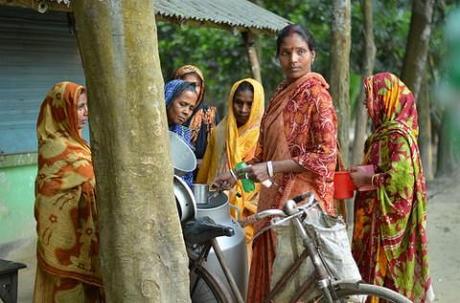
Collecting milk from women dairy farmers in Bangladesh. (Photo: Akram Ali/CARE Bangladesh)
Although exact data is difficult to come by, it is estimated that women control as little as 2 percent of the land in Bangladesh. According to a survey of selected countries by the Food and Agriculture Organization of the United Nations (FAO), this leaves Bangladesh tied with Mali in second to last place out of 12 countries, ahead of only Saudi Arabia. I used the FAO’s data to compare Bangladesh to some of its neighbors and found land ownership by women at 11 percent in India and the Philippines, 9 percent in Indonesia, and 8 percent in Nepal (data is not available for all countries).
This is surprising given the central role of women in Bangladesh’s economy. According to the World Bank, 90 percent of the 2.5 million workers in the garment industry are women. And the garment industry is the lifeblood of Bangladesh; it has been the only sector showing significant growth. At $20 billion, the garment industry now accounts for more than 75 percent of exports.
The role of women in Bangladesh extends far beyond the garment industry. Since 1991, two women have held the office of prime minister and 19 women have been elected to parliament beyond the 50 required by law. Despite these important contributions, women remain under-represented at all levels of society, and gender equality is still sorely lacking in many areas.
Women’s land ownership might not immediately seem to be the most important of issues. Although land ownership provides wide-ranging benefits to women, as well as their families and the economy as a whole, gender equality is a goal that needs no other justification. Nonetheless, it is worth reviewing the specific benefits of increasing the proportion of land owned by women.
The 2010 Millennium Development Goals Global Action Plan recognized the importance of “promoting and protecting women’s equal access to housing, property, and land, including rights to inheritance.” For the poor, land is often the only asset they own. Land ownership provides women with more control and security over their lives and the lives of their family which leads to benefits such as reduced domestic violence and rates of HIV/AIDS. Land ownership provides security for women, protecting them from eviction. In agriculture, where gender differences exist in land ownership, land farmed by women is less productive; the women use less fertilizer and seed varieties.
Preventing women from owning land puts them at a distinct disadvantage in participation in the economy. Land is a key source of credit that provides financing for business. The lack of land therefore puts women entrepreneurs at disadvantage, such that they find themselves running smaller businesses in less productive sectors. CIPE supported the Bangladesh Women’s Chamber of Commerce and Industry in their advocacy efforts to get banks to provide loans to women entrepreneurs without collateral. Even with the success of those efforts, having land as collateral would allow more women to obtain larger loans and start more productive businesses.
The economist Hernando de Soto has long championed the importance of land ownership, particularly when it comes to accessing credit. One of his key arguments was that land ownership provides a path for people in the informal economy to enter the formal economy. A land title provides people access to courts and an ability to enforce their rights. In Bangladesh, of the total female employed labor, 92 percent are employed in the informal sector.
Although Bangladesh has enjoyed fairly stable economic growth, it remains a very poor country with a per capita GNI of about $2,000. The country faces many challenges, including natural disasters, endemic corruption, worker safety, and energy shortages. But promoting gender equality should not be forgotten. In fact, improved gender equality will likely improve Bangladesh’s ability to deal with its other challenges.
Tim Wallace is Assistant Program Officer for South Asia at CIPE.

